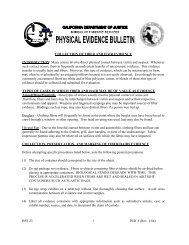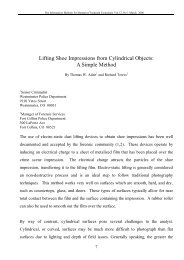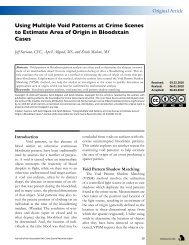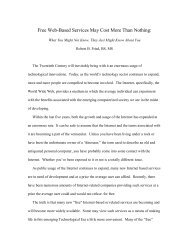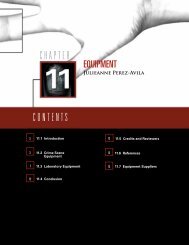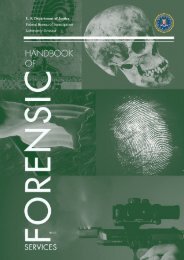PHYSICAL EVIDENCE MANUAL - Crime Scene Investigator Network
PHYSICAL EVIDENCE MANUAL - Crime Scene Investigator Network
PHYSICAL EVIDENCE MANUAL - Crime Scene Investigator Network
You also want an ePaper? Increase the reach of your titles
YUMPU automatically turns print PDFs into web optimized ePapers that Google loves.
Physical Evidence Manual<br />
Adopted: May 2002<br />
Revisions: 6<br />
Last Revision: January 31, 2008<br />
1.0 PREFACE<br />
The need for proper recognition, collection, and preservation of physical<br />
evidence is mandated for use in the criminal justice system. Physical evidence<br />
can directly or indirectly lead to the solution of a crime. Charging and prosecution<br />
decisions may be affected by the quality of the physical evidence supporting the<br />
case. United States Supreme Court and Oregon Supreme Court decisions have<br />
placed great emphasis upon physical evidence in criminal cases.<br />
The Oregon State Police (OSP) Forensic Services Division (FSD) provides an<br />
important link between collection and court presentation of such evidence. It<br />
sometimes happens, however, that materials submitted to the laboratory prove<br />
inadequate for proper analysis or that improper collection or packaging methods<br />
destroy valuable evidence.<br />
A member of the Criminal Justice System may not know the proper way to collect<br />
and preserve evidence in all situations he/she may encounter. In addition, they<br />
may not in every case understand what the various laboratory methods may<br />
involve or why some seemingly “irrelevant” piece of evidence should require such<br />
careful handling. Therefore, the FSD reserves the right to select the appropriate<br />
methods for analysis. It also reserves the right to transfer evidence between the<br />
laboratories of the Divison to best be able to service the request.<br />
This handbook is offered in the belief that increased knowledge leads to<br />
understanding and that understanding leads to excellence. It was written to<br />
provide information regarding the legal and laboratory requirements surrounding<br />
collection and preservation of physical evidence.<br />
This handbook in not intended to be a comprehensive treatment of all of the<br />
factors involved in criminal investigations. Rather, it is a general procedural guide<br />
outlining methods for collecting and preserving physical evidence. Readers<br />
should keep in mind that the information and procedures presented here are<br />
intended to be used as guidelines when encountering other types of evidence not<br />
specifically covered.<br />
Because the laws and legal precedents concerning the collection of physical<br />
evidence are subject to change, it is impossible to give specific up-to-date<br />
information on acceptable procedures. It is, however, of utmost importance that<br />
great care be taken to use only approved methods when obtaining evidence of<br />
any kind. Therefore, it is imperative that during an investigation a close liaison is<br />
maintained between the District Attorney’s Office, the Oregon State Police<br />
Forensic Laboratory, and those persons responsible for the collection of physical<br />
evidence.<br />
1-1



